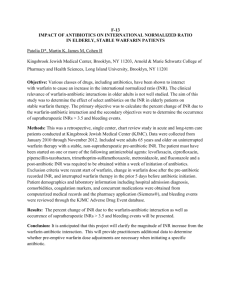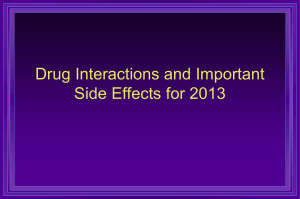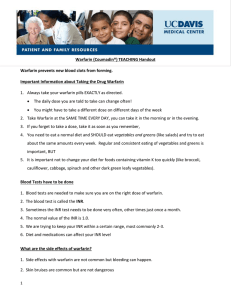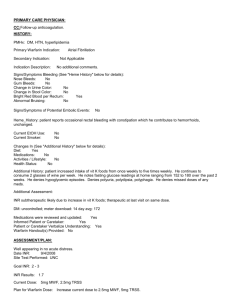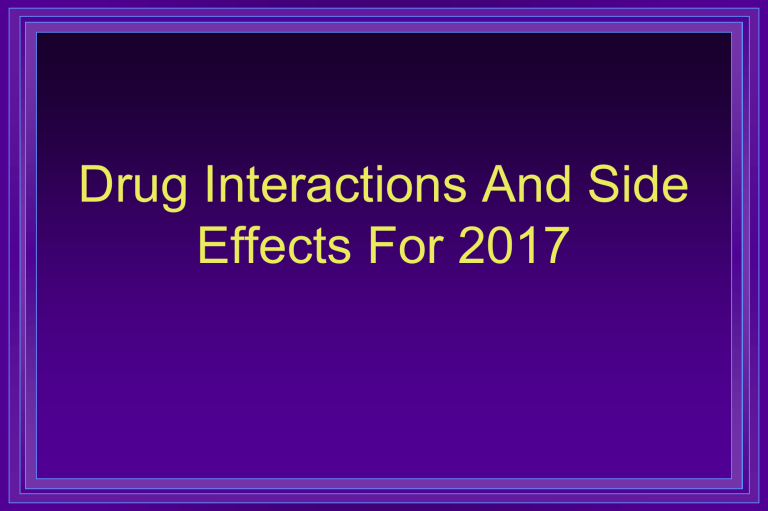
Drug Interactions And Side Effects For 2017 Disclosure of Financial Relationships Douglas Paauw Has no relationships with any entity producing, marketing, re-selling, or distributing health care goods or services consumed by, or used on, patients. “One of the first duties of the physician is to educate the masses not to take medicine.” ― William Osler Outline In the news/FDA warnings Common drugs with side effects Drug Interactions A 60 yo man develops pain in his feet over the past week. He describes the pain as burning, and sharp. No swelling, or redness. PMH: alcoholism (quit drinking 3 years ago), hypertension, CAD, prostatitis, and diabetes. Meds: rosuvastatin, lisinopril, metformin, levofloxacin, amlodipine. Examhyperasthesia both feet. What do you recommend? A) Start B12 supplementation B) Stop Rosuvastatin C) Stop Metformin D) Stop Levofloxacin E) Stop Amlodipine Quinolones and Peripheral Neuropathy Known since 1990’s Can occur within 1st 24 hours on medication, most within 1 week Parasthesia most common intitial symptom (81%) FDA clarified this concern 8/2013 J Antimicrob Chemother. 1996 Apr;37(4):831-7 Ann Pharmacother. 2001 Dec;35(12):1540-7 Quinolones and Tendon Rupture Reports of shoulder, hand, and Achilles tendon ruptures in patients on quinolones Achilles tendon: most common site Can occur anytime during the course of treatment and even after treatment Black box warning added 2008 Risk is greatest if corticosteroids are being used and in older patients Quinolones and Collagen Associated Adverse Events Population-based longitudinal cohort study in Ontario, Canada Adults turning 65 years were tracked for 15 years Fluoroquinolone prescriptions were tracked with patients considered at risk during and for 30 days following a treatment course. 1 744 360 eligible patients, 657 950 (38%) recieved a fluoroquinolone prescription tendon ruptures (0.82 vs 0.26/100-person years, p<0.001) and aortic aneurysms (0.35 vs 0.13/100-person-years, p<0.001). BMJ Open 2015;5:e010077 Quinolones and Collagen Associated Adverse Events Severe collagen-associated adverse events were more common during fluoroquinolone treatment , including tendon ruptures ( p<0.001), and aortic aneurysms ( p<0.001). Current fluoroquinolones were associated with an increased hazard of tendon rupture (HR 3.13) and an increased hazard of aortic aneurysms (HR 2.72) that were substantially greater in magnitude than the association of these outcomes with amoxicillin. BMJ Open 2015; 5e010077 Quinolone Side Effects Tendon rupture Insomnia/confusion Peripheral neuropathy Arrhythmia Aortic disease Retinal detachment? FDA Warning on Flouroquinolones 7/2016 Because of long term tendon/neurologic risk, FDA advises that fluoroquinolones should not be prescribed if other alternatives are available for patients with: Acute sinusitis Cystitis Acute bacterial exacerbations of chronic bronchitis A 30 yo woman with a history of severe depression comes to the clinic with her family because of concerns about recent frequent gambling. The patient also mentions that she has severe credit card debt because of recent frequent online and outlet mall shopping sprees. Before this year had not previously gambled. She has had 2 hospitalizations for depression in the past 3 years. Current mediciations: Fluoxetine, bupropion,aripiprazole, zolpidem, and levonorgestrel IUD What is the most concerning cause for her gambling/spending? A) B) C) D) E) Fluoxetine Aripiprazole Bupropion Zolpidem levonorgestrel IUD Aripiprazole and Impulse Control Disorders Nested case-control study of large US health claims database Cases were defined as subjects newly diagnosed with gambling disorder or impulse control disorder Users of aripiprazole had an increased risk of pathologic gambling RR 5.23; [CI], 1.78–15.38) and impulse control disorder (RR, 7.71; CI, 5.81–10.34). Journal of Clinical Psychopharmacology • Volume 37, Number 1, February 2017 Aripiprazole FDA Warning 5/3/2016 FDA is warning that compulsive or uncontrollable urges to gamble, binge eat, shop, and have sex have been reported with the use of the antipsychotic drug aripiprazole (Abilify) Health care professionals should make patients and caregivers aware of the risk of these uncontrollable urges when prescribing aripiprazole, and specifically ask patients about any new or increasing urges while they are being treated with aripiprazole. No Time Lost! Have You or a Loved One Taken Abilify and Suffered from Gambling Addiction? - See more at: http://www.youhavealawyer.com/abilify/gamblin g/#sthash.fssryApA.dpuf Abilify May Be Linked to Gambling Problems, Impulse Control Side Effects - See more at: http://www.aboutlawsuits.com/abilify-impulsecontrol-study-72747/#sthash.iucrPk8w.dpuf A 62 yo man with a hx of MI 4 years ago presents with right hip pain. He has had discomfort with walking for the past 6 months. Xray reveals moderate osteoarthritis. Most recent labs: Bun 6 Cr .8 Glu 100 What would be the most appropriate management plan? A) Acetaminophen B) Oxycodone C) Ibuprofen D) Diclofenac E) Celecoxib Risk of MI with NSAID Use Nationwide cohort study in Denmark. 99,187 patients with a mean age of 69 Studied pharmacy records and medical records for of patients over age 30 with a first time admission for MI over 12 years Subsequent NSAID use was tracked HR for Death with NSAID use was 1.59 at 1year, 1.63 at 5 years. Risk for recurrent MI was 1.3 at 1 year, 1.41 at 5 years. Circulation 2012, 126: 1955-1963. Also, Even short-term treatment with most NSAIDs was associated with increased risk of death and recurrent MI in patients with prior MI. (Circulation. 2011;123:2226-2235.) Use of NSAIDS during URI associated with MI (J Infect Dis. 2017 . Feb 1. ) Risks of NSAIDS and Coxibs Large meta-analysis of trials looking at NSAID/Coxib risk Outcomes of interest were major vascular events (fatal vascular event, non-fatal MI or stroke), major coronary events (fatal or non-fatal MI), stroke, hospitalization for heart failure, death, and upper GI complication (perforation, obstruction or bleed) 639 RCT involving >225,000 participants . Coxibs and diclofenac were associated with an increased RR of major vascular events,Ibuprofen an increased risk of MI , all NSAIDS and Coxibs increased risk for CHF hospitalizations, and all increased GI bleeding risk (lowest coxibs (RR 1.8, highest naproxen (RR 4.33) The Lancet 2013 382:769 Is Celecoxib safer? PRECISION (Prospective Randomized Evaluation of Celecoxib Integrated Safety versus Ibuprofen or Naproxen) is a noninferiority, multicenter, randomized double-blind trial of celecoxib versus ibuprofen versus naproxen used for the daily treatment of osteoarthritis or rheumatoid arthritis in patients with an increased cardiovascular risk. Primary outcome CV events No statistical difference in CV outcomes: celecoxib, 2.3%; naproxen, 2.5%; and ibuprofen, 2.7% Less GI bleeding with celecoxib, renal events same with naproxen/celecoxib, more with ibuprofen N Engl J Med; 2016;November 13 NSAIDS and CHF in the elderly 365 cases of patients admitted with CHF compared to 658 control patients admitted without CHF NSAID users had an odds ratio of 2.1 for admission for CHF Odds ratio of 10.5 for first admit for CHF if patient had heart disease and used NSAIDS Risk of admission for CHF correlates with dose of NSAID and long acting drug Arch intern med 2000;160:777-784 Scope of NSAID Induced Gastrointestinal Toxicity Combined gastric/duodenal ulcers in 10-25% of arthritis patients chronically treated with NSAIDS Estimated 103,000 hospitalizations annually in US for GI complications of NSAIDS Estimated cost > 2 Billion $ 15th leading cause of death in US N Engl J Med 1999;340:1888–99. SSRI’S and GI Bleeding Multiple retrospective studies show relative risk for UGI bleeding of 3-4 with the use of SSRI’s Risk is further increased with concurrent use of a nonsteroidal, Odds ratio 6.33 if SSRI combined with NSAID Risk is highest in the elderly Strongly consider gastroprotection if combination used in patients with history of UGI bleeding, in patients taking NSAIDS or the elderly Arch Intern Med 2003;163:59-64 BMJ 1999; 319 (7217):1106-9. Aliment Pharmacol Ther 2008; 27: 31-40. Meta-analysis Clin Gastroenterol Hepatol. 2009 Dec;7(12):1314-21. Bottom Line on NSAIDS and CV Risk? FDA strengthened NSAID cardiovascular risk warning 7/2015 FDA Warnings on SGLT-2 Inhibitors 5/2105- ketoacidosis (canagliflozin, dapagliflozin, empagliflozin) 6/2016- Acute Kidney injuryCanagliflozin and dapagliflozin 5/2017 – increased amputation risk Common Drugs with Side Effects A 60 yo man with CAD returns for followup. He has stopped his pravastatin because of myalgias. He previously had myalgias with atorvastatin and lovastatin. He is wary of trying another statin because of myalgias. What do you recommend? A) Restart pravastatin and take naproxen daily B) Check Vitamin D level C) Start Coenzyme Q10 D) Ezetimibe 10 mg a day Side Effects of Statins Rhabdomyolysis (rare) 0.01% Liver failure 0.0001% Statin Associated Muscle Sx 5-18 % Cataracts? Diabetes? Cognitive impairment? Do Statins Increase Diabetes? Retrospective cohort study compared 3,351 pts on statin therapy for primary prevention with 25,970 controls in a health insurance database (1) • Statin users had higher odds of new diabetes (OR = 1.87 95% CI 1.67-2.01) compared to their matched controls Meta-analysis of 13 RCTs (n=91,140) of statins → OR of 1.09 for a new Dx of DM (2) 1) 2) J Gen Intern Med 2015;30(11):1599-610 Diabetes Care 2014;37:S14-S80 Does it Matter? For every 255 patients treated over 4 years: • 1 new case of diabetes • 5.4 vascular events prevented Diabetes Care 2014;37:S14-S80 Other Stain Concerns Memory problems No evidence linking to dementia or MCI Conflicting results on benefit Trends Cardiovasc Med. 2016 Aug;26(6):550-65. Neuropathy Possibly- OR 1.3 in cross sectional study J Diabetes. 2013 Jun;5(2):207-15. The Latest on Coenzyme Q10 Meta-analysis of randomized controlled trials 6 trials (302 participants) No significant effect on muscle pain, or effect on plasma CK levels Mayo Clin Proc 2015; 90(1):24-34. Is Vitamin D Important in Statin Related Myalgias? Meta-analysis of 7 studies with over 2400 patients , myalgias were associated with lower vitamin D levels (1) In a study of 146 patients with muscle symptoms to 2 or more statins who had low vitamin D levels (<32 ng/mL) were treated with vitamin D (50,000100,000 u/week). Vitamin D levels rose to an average of 55 ng/mL at 24 months and 95% of the previously statin intolerant patients were free of myalgias at 24 months while takin statins (2) 1) Int J Card 2015; 178:111-116 2) N Am J Med Sci 2015;7(3):86-93 SAMS and Vitamin D 120 patients with prior SAMS enrolled in 8 week ,cross over, placebo controlled trial simvastatin 20 mg or placebo. Vitamin d levels measured during each phase 43 (35.8%) experienced muscle pain on simvastatin and not placebo (True SAMS). 21 (17.5%) had no pain on either treatment, 21 (17.5%) had pain with both treatments, and 35 (29%) had pain only with placebo. Patients with true SAMS had a higher CK Baseline and on statin CK was inversely correlated with vitamin D level Atherosclerosis 2017; 256: 100-104 Same 60 yo statin intolerant patient responds that “he doesn’t believe in that natural crap” and wants to know what medication you want to prescribe next. What do you recommend? A) Restart Pravastatin B) Restart Pravastatin taken with Naproxen daily C) Start Rosuvastatin 10 mg Twice a week D) Start Simvastain 5 days a week (drug holiday on the weekend) Twice Weekly Rosuvastatin for Patients With Statin Myalgias Retrospective chart review of previously statin intolerant patients in a lipid lowering clinic 40 patients received rosuvastatin 5mg twice a week (30) or rosuvastatin 10mg twice a week (10) Mean LDL reduction was 43, with 54% reaching NCEP goal 8 patients (20%) discontinued rosuvastatin due to side effects AM J Cardiol 2008;101:1747-1748 Approach to Management of Myalgias on Statins Check CK ,TSH, Vitamin D Stop statin, when symptoms disappear restart statin at lower dose (up to 70% success with same statin rechallenge*) or change statin (30-40% success*) If recurrent symptoms try Fluvastatin 80mg XL QD or low dose rosuvastatin daily,QOD or 2X weekly (could also try atorvastain every other day) If symptoms continue options include ezetimibe or PCSK9 inhibitors * J Clin Lipid 2016;10(5): 1067-72. A 66 yo woman presents with fatigue. She has a history of bipolar disorder and reflux disease. She has felt well the past few months until the last few weeks. Medications: Rabeprazole, lithium, paroxetine, calcium. Physical exam is normal. As part of her workup she is found to have the following labs: Na 120, K 3.6 Bun 3 Cr 0.7 What is the most likely cause of her low sodium? A) Hyperlipidemia B) Lithium C) Acute psychosis D) Rabeprazole E) Paroxetine SSRI’s AND Hyponatremia Older age Female Concomitant diuretic use Low body weight Ann Pharmacother. 2006 Sep;40(9):1618-22 Drug Induced Hyponatremia Hydrochlorathiazide/indapamide (38%) (1) SSRI’s (2,3) SNRI’s (2,3) NSAIDs Carbemazipine (2) MDMA (ecstasy) 1)Saudi J Kidney Dis Transpl. 2013 Mar;24(2):281-5. 2) Int J Neuropsychopharmacol. 2012 Jul;15(6):739-48 3) Curr Drug Saf. 2013 Jul;8(3):175-80. A 85 yo man is brought to the ED for evaluation of weakness and nausea. He was diagnosed 10 days ago with prostatitis. His other problems include hypertension, CHF and CRI. Meds: Carvedilol, furosemide, TMP/Sulfa, verapamil, digoxin. ExamBP 100/60 P-100 T 36.9 lower extremity edema present. Lab: Na- 132 K -6.8 BUN 37 Cr- 2.3. Two weeks ago, creatinine was 1.6 and K was 4.8. What is the most likely cause of his hyperkalemia? A) Chronic renal insufficiency B) Carvedilol C) TMP/Sulfa D) Verapamil E) Digoxin Why Did His Creatinine Increase? Trimethoprim Induced Increase in Creatinine Trimethoprim causes a reversible inhibition of tubular secretion of creatinine (Which resolves within 1 week of stopping the drug) Br J Urol. 1985 Jun;57(3):265-8. Trimethoprim-Sulfamethoxazole and Hyperkalemia Population based, nested case-control study of patients 66 or older who were receiving and ACEI or ARB (14 years) Case patients were those who had hyperkalemia within 14 days of receiving an antibiotic. For each case patient 4 controls were matched. 4148 admissions due to hyperkalemia. Compared to amoxicillin the relative risk for hyperkalemia with TMP-sulfa was 6.7 (CI 4.5-10) . No other antibiotic posed a significant risk for hyperkalemia. Arch Intern Med 2010; 170(12): 1045-1049. TMP/Sulfa and Sudden Death OBJECTIVE: To determine whether the prescription of cotrimoxazole with an angiotensin converting enzyme inhibitor or angiotensin receptor blocker is associated with sudden death. Of 39,879 sudden deaths, 1027 occurred within seven days of exposure to an antibiotic and were matched to 3733 controls. Relative to amoxicillin, co-trimoxazole was associated with an increased risk of sudden death (adjusted odds ratio 1.38, 95% confidence interval 1.09 to 1.76). BMJ. 2014 Oct 30;349 Trimethoprim Induced Hyperkalemia More common in elderly and patients with renal impairment More likely if patient is on an ACEI or ARB More likely if patient is receiving high doses of steroids Mechanism is that trimethoprim acts like amiloride, a potassium sparing diuretic, and reduces urinary potassium excretion by 40% A 66 yo woman with osteoporosis is evaluated prior to dental work. She has received alendronate for the past 6 months What is her risk for osteonecrosis of the jaw ? A) .01% B) 1% C) 5% D) 15% Risk of MRON General population .001% Treated osteoporosis .01% Patients with malignancy treated with IV bisphosphonates up to 15%. The longer the patient has been on treated, the greater the risk- 1% at one year, 13% by 4 years Zoledronate with its extreme potency has a 15X increased risk over other bisphosphonates Invasive dental procedures increase risk 5X Dental Implants in Patients on Bisphosphonates Dental implants may be safely placed in patients on bisphosphonates > 5 years (1) No patients who had been on bisphosphonates for 1-4 years developed osteonecrosis (2) 1) Advisory Task Force on Bisphosphonate-Related Ostenonecrosis of the Jaws, American Association of Oral and Maxillofacial Surgeons. American Association of Oral and Maxillofacial Surgeons position paper on bisphosphonate-related osteonecrosis of the jaws. J Oral Maxillofac Surg 2007; 65 (3) 369-376 2) Jeffcoat MK. Safety of oral bisphosphonates: controlled studies on alveolar bone. Int J Oral Maxillofac Implants 2006; 21 (3) 349-353 FDA Advisory on Bisphosphonates and Musculoskeletal Pain Strongly consider bisphosphonate as cause for musculoskeletal pain in patients who are taking them and have severe pain Strongly consider temporarily or permanently stopping the medication Much more likely with weekly or monthly dosing Drug Interactions A 65 yo man presents with cough and fever. He has had severe diarrhea for 2 days. He was on a cruise with a friend who was diagnosed with Legionella yesterday. PMH – diabetes, hyperlipidemia,hypertension. Meds: Lisinopril, simvastatin, amlodipine, gemfibrozil,metformin. Chest Xray shows patchy bilateral infiltrates. WBC 17,000 Na 125. What is the most appropriate treatment? A)Amoxicillin/clavulanate B)Clarithromycin C)Levofloxacin D)Cefuroxime E)Trimethoprim/sulfa Drug Interactions in This Case Gemfibrozil- simvastatin (rhabdomyolysis) Simvastatin- clarithromycin (rhabdomyolysis) Amlodipine- clarithromycin (hypotension) Drugs That Increase Risk of Statin Toxicity Fibrates (Gemfibrozil 15X >> Fenofibrate) Azole antifungals Amiodarone Erythromycin/Clarithromycin Protease inhibitors Verapamil/Diltiazem (less amlodipine/nifedipine except with simvastatin) Least drug interactions with pravastatin, most with simvastatin and lovastatin Non concurrent dosing can help A 72 y.o. male S/P AVR replacement two years ago for aortic stenosis presents with wide spread bruising on his back/legs and some bruising on the back of both hands. His last INR was three weeks ago and was 3.0. He states he saw an M.D. six days ago for a cough and was put on a medication described as a “white tablet.” His chronic medications include: Coumadin 5 mg qd, Albuterol inhaler 2 puffs 4 times a day and Nortryptiline 25 mg qhs. What medication was he placed on? a) Amoxicillin b) Codeine c) Cefixime d) Azithromycin e) TMP/Sulfa Warfarin Interactions Decrease metabolism (increase PT) Most Severe TMP/Sulfa Erythromycin Amiodarone Propafenone Ketoconazole/fluconazole Itraconazole Metronidazole Possible* Quinolones Omeprazole Clarithromycin Azithromycin * Especially in elderly and polypharmacy Antibiotics and Warfarin Retrospective cohort study 104 patients on stable warfarin therapy. Effect on INR of Terazocin (control), Azithromycin (32 patients), Levofloxacin (27) and TMP/Sulfa (16) Mean change in INR: Terazocin -.15, Azithromycin + .51 , Levofloxacin + .85, TMP/Sulfa +1.76 Percent patients having a INR > 4: Terazocin 5%, Azithromycin 31%, Levofloxacin 33%, TMP/Sulfa 69% JGIM 2005;20 (7);653-6. Risk of UGI Hemorrhage in Warfarin Treated Patients Receiving Antibiotics TMP-Sula Ciprofloxacin Amoxicillin Nitrofurantion Odds Ratio 3.84 (CI 2.33-6.33) 1.94 (CI 1.28-2.95) 1.37 (CI .92-2.05) 1.40 (CI .71-2.75) Arch Intern Med 2010; 170(7):617-621) Preemptive Warfarin Dose Reduction For TMP/Sulfa and Levofloxacin Efficacy of preemptive 10-20% DR vs. no change in warfarin dosing in 40 chronically anticoagulated patients initiating trimethoprim-sulfamethoxazole (TMP-SMX) or levofloxacin. Of DR group patients treated with TMP-SMX, 0/8 developed a subtherapeutic INR, while 4/10 of levofloxacin-treated patients developed a sub-therapeutic INR. Prophylactic warfarin DR of 10-20% is effective in maintaining therapeutic anticoagulation in patients initiating TMP-SMX. Early monitoring is preferred approach with levo J Thromb Thrombolysis. 2008 Aug;26(1):44-8. A 76 yo man is admitted with increasing SOB. He has a long history of COPD and has had a recent productive cough. He is admitted to the hospital and treated with amoxicillin, prednisone, codeine, and albuterol. PMH: A fib, Hypertension, COPD, GERD. Outpatient meds: Metoprolol, coumadin, pantoprazole, lisinopril. His recent INR 2 weeks ago was 2.2, on hospital day 6 it is 4.3. What is the most likely interaction with coumadin? A) Prednisone B) Amoxicillin C) Codeine D) Amoxicillin + Pantoprazole Effect of Oral Corticosteroids On Warfarin Therapy Retrospective review of patients in ACC who received oral corticosteroids. Patients were excluded if they were treated with any drug with a known interaction with warfarin. Mean difference between pre steroid INR and the INR when patients on steroids was 1.24, p<.001. 62% of the patients had an INR above their targeted range. Mean time to INR elevation was 6.7 days after starting steroids. Ann Pharmacother 2006;40:2101-6. Preemptive Dose Reduction of Warfarin When Receiving Prednisone No statistical difference in over anticoagulation between DR group and control A higher percentage of DR patients had a subtherapeutic follow-up INR compared to control (40 vs. 5.9%, P = 0.02). J Thromb Thrombolysis. 2011 May;31(4):472-7. Important Warfarin Interactions TMP/Sulfa (#1) Acetaminophen (almost never suspected) Prednisone (also rarely suspected) Simvastatin (mild, but no one has heard of this) Omeprazole (also another surprise) Drug Interactions with Xa Inhibitors Xa inhibitors- rivaroxaban (xeralto), apixaban (eliquis) Increased risk of bleeding :ketoconazole, itraconazole, clarithromycin, ritonavir Decreased efficacy: carbamazipine, phenytoin, St John’s wort, rifampin What To Remember From This Talk Quinolones under greater scrutiny because of serious side effects NSAIDS should be avoided in patients with CV disease Osteonecrosis of the jaw is rare in patients treated with bisphosphonates for osteoporosis Statin Associated Muscle Symptoms are complex
